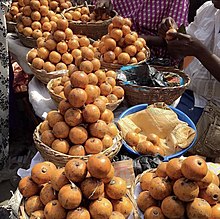Gambeya albida
| Gambeya albida | |
|---|---|
| Scientific classification | |
| Kingdom: | Plantae |
| Clade: | Tracheophytes |
| Clade: | Angiosperms |
| Clade: | Eudicots |
| Clade: | Asterids |
| Order: | Ericales |
| Family: | Sapotaceae |
| Genus: | Chrysophyllum |
| Species: | C. africanum
|
| Binomial name | |
| Chrysophyllum africanum | |
Chrysophyllum africanum[inconsistent] (commonly known as African star apple[1]) is a forest fruit tree commonly found throughout tropical Africa.[1]

Amongst the Yoruba of Nigeria, it is called agbalumo, while it is called characteristically-called udala (udara) among the Igbo, with the usage of the latter term, coincidentally, also permeating across much of southern Nigeria (i.e., further east of Akoko-Ondo) the northern (Hausa-Fulani) parts of the country. One local enduring sobriquet is derived from the Yoruba agbalumo, i.e., ‘agbaluma,’ and is used in certain parts of Nigeria.
The inherent sweetness of a child (or person of especially-seasoned cognisance/age who otherwise displays certain amiability-desirable characteristics representative of children and/or well-adjusted adults, e.g., well-roundedness, joviality, unassuming understanding) has been likened to the fruit in Igbo, as ‘udala nwannu.’
Although its culinary (and overall) exploitation have not been known to expand beyond the province of simply eating the much-prized fruit, subjective advocates have been made across certain lines suggesting its wood be used to smoke certain foods in a Nigerian/Igbo context (some curiously-experimental, some conventional) as shawarma meat, ofe akwu (banga stew), cast-iron-‘potted’ jollof rice, coconut rice, efo-riro, ofe-egusi, okro soups, [pumpkin] yam porridge and ofe-oha. The foods that occupy a certain intermediate position between ofe-ora and jollof rice, which assume more of a definitively-concrete culinary stamp among the Igbo than the Yoruba and other non-Igbo ethnic groups, are especially-advocated for in certain esoterically-subjective circles as especially-benefiting from the infusion of the ‘tropical apple-wood smoke’ that would be imparted by way of corresponding usage of said tree-wood. These foods may be summarised as, in a no-means exhaustive list, banga rice {which essentially-represents to ofe akwu what jollof rice does to white rice and [red] stew}, all manner of transitional forms between banga rice and conventional jollof rice (helped by the addition of coconut) and okra soup (ofe-okwuru/okwulu) where prominent ingredients include ehuru (Calabash nutmeg), uziza (false cubeb) and turkey meat. The heretofore-stringently-protected meat of flamingo has also been subjectively-deemed as fitting protein-compliments for these potentially-rendered dishes or even to take the place of (or compliment) (smoked) meat of any kind, in this futuristic model smoked specially with the wood of udala.
.[2] It is closely related to the African star apple(Chrysophyllum africanum) which is also common throughout West Africa. Some schools of thought feel that they may just be a variety of the same species. Also in the family is the purple star apple (Chrysophyllum cainito).[2]
References
- ^ a b "Gambeya albida". Germplasm Resources Information Network. Agricultural Research Service, United States Department of Agriculture.
{{citation}}:|access-date=requires|url=(help) - ^ a b Lost Crops of Africa: Volume III: Fruits. Washington, DC: The National Academies Press. 2008. p. 321. ISBN 978-0-309-10596-5.
- National Research Council. 2008. Lost Crops of Africa: Volume III: Fruits. Washington, DC: The National Academies Press. https://doi.org/10.17226/11879
External links
National Research Council. 2008. Lost Crops of Africa: Volume III: Fruits. Washington, DC: The National Academies Press. https://doi.org/10.17226/11879
